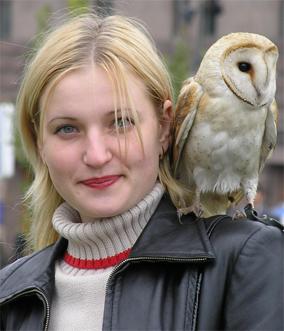当前位置: 首页 > 网络学院 > 设计教程 > 设计理念 > 数码摄影中避免出现高压缩率的图片
For users of digital cameras, file compression is an issue you must be aware of if you want to be able to view and share your images.
数码相机使用者如果希望拍摄出高质量的图片,就必须注意文件压缩这个术语。
If you put in the time and effort of taking a good photograph, wouldn't you want the captured image to be as good as it can be? File compression can impact on your photos. And while the number of photos you can get on your storage media (be it compact flash, smart media, or numerous others) can be very tempting when you have it set to high compression, to get the best out of your photos you will need to sacrifice the small file size of highly compressed images for the better
既然花费时间和精力拍摄图片,就要保证图片效果达到最好。文件压缩会影响图片质量,在高压缩率下,储存媒体(可以是简单flash、灵活媒体或者其它许多媒体)中的图片会很吸引人,但为保持图片质量,你最好舍弃高压缩率下小尺寸的图片。
Quality of lower compression:
低压缩率下的图片质量:

Quality of higher compression:
高压缩率下的图片:

When you take a photo with your digital camera, the camera stores it as a file on your camera's storage medium.
数码相机拍摄时,会把照片当作文件保存在存储器中。
Most digital cameras allow the users to choose the file type the images are stored as. Most cameras include at least two types of JPEG files - high-compression & low-compression, and some allow you to save the files as TIFF or RAW files as well. The major difference between the file types is how much, if any, they compress the data in your image - and this will determine the quality of your images.
大多数数码相机可以让用户选择图片储存的文件类型,这些相机至少有两种JPEG文件类型(高压缩率和低压缩率),甚至有的相机会提供TIFF或者RAW格式。这些文件类型的主要区别在于:图片中数据的压缩程度不同,这个因素决定图片质量。
When you take images as TIFF or RAW files, the data are not compressed at all, or are stored using "lossless" compression. This means that, when you open the file in your photo editing or viewing program, all the information that was originally recorded by the camera is still there. So while the files are much larger than corresponding JPEG files, the photos you can print will be of a much higher quality.
TIFF或者RAW格式的图片中,数据没有完全压缩,或者说这些图片是在未压缩的情况下保存的。这就意味着在编辑或者观看图片的时候,照片信息是相机记录的原始信息,因此与相应的JPEG格式相比,这些图片尺寸比较大,打印照片的质量较高。
The data in JPEG files are compressed when you create a file. JPEG files use a "lossy" form of compression, which means that in exchange for a small file size (and room for more photos on your camera's storage card), some of the information recorded by the camera is lost. The amount of compression is determined by your camera's manufacturer. A high-compression JPEG file is much smaller than a low- compression JPEG file, but more information is lost from the original image, and more artifacts from the file compression can be seen in the photo. So, the more a file is compressed, the more likely you are to see the annoying jagged lines disrupting your image.
在创建文件时,JPEG文件中的数据已压缩。JPEG利用压缩的有损耗模式,也就是说,这种格式会去除数码相机存储的部分信息,以减小文件尺寸,让相机存储卡储存更多的照片。相机压缩率是由相机生产商决定的,高压缩率的JPEG文件比低压缩率的JPEG文件,尺寸要小,但去除的原始信息更多,照片质量更差。所以,文件压缩率越大,照片中出现的干扰(锯齿状线条)越多。
For example - with my Nikon 775 camera - I have three choices for the file type or image quality setting. All three are JPEG files - a low-compression mode (Fine mode), a medium-compression mode (Normal mode) and a high-compression mode (Basic mode). The files taken in Fine mode are about four times as large as the ones created in Basic mode. The smaller files have been compressed much more than the larger ones - and are much more likely to show lines and pixels that have been affected by the file compression.
比如说,利用Nikon 775相机拍照时,我有三种文件类型选择,或者说三种照片质量选择。三种模式分别为:低分辨率模式(最佳模式)、中分辨率模式(正常模式)、高分辨率模式(基本模式),最佳模式的图片尺寸是基本模式的4倍。尺寸越小,压缩率越高,图片质量越差。
You may not be able to see the differences in the images on the view screen on your camera. But they will become visible on your computer monitor, and especially when you print your pictures.
你可能在相机屏幕中观察不到这些区别,但在电脑屏幕中,对比就很明显,尤其是图片打印出来之后,效果一目了然。
So if you want to avoid the little jagged lines and other artifacts of JPEG compression in your images - the first thing you should do is check the settings in your camera. Set the file quality for the highest quality you can -either a low-compression JPEG file or even better a non-compressed file type such as TIFF or RAW.
如果要避免JPEG图片中的锯齿线或其它干扰因素,首先你应该检查相机的设置。相片质量设置到最佳,也就是说设置到JPEG文件的低分辨率状态或者是没有压缩的TIFF或者RAW格式。
Give you the largest image files your camera can produce, which will give you more data to work with when you edit your images. If all you are doing is making small images for the web, these factors will not matter much, but if you plan on enlarging or printing, then the camera's resolution and file compression settings will be important. The end result will be better images that you can enlarge without having to worry as much about loss of image quality.
保留最大的图片尺寸,这样,编辑图片时可以利用更多数据。如果只是为小网站设计图片,这些因素就不很重要,但如果打算扩大或打印图片,相机的分辨率和压缩设置就成为重要的考虑因素。这样放大的图片质量会更好,不必担心照片失真。
 设计理念 中的 数码摄影中避免出现高压缩率的图片
设计理念 中的 数码摄影中避免出现高压缩率的图片


 评论 (0)
评论 (0) 